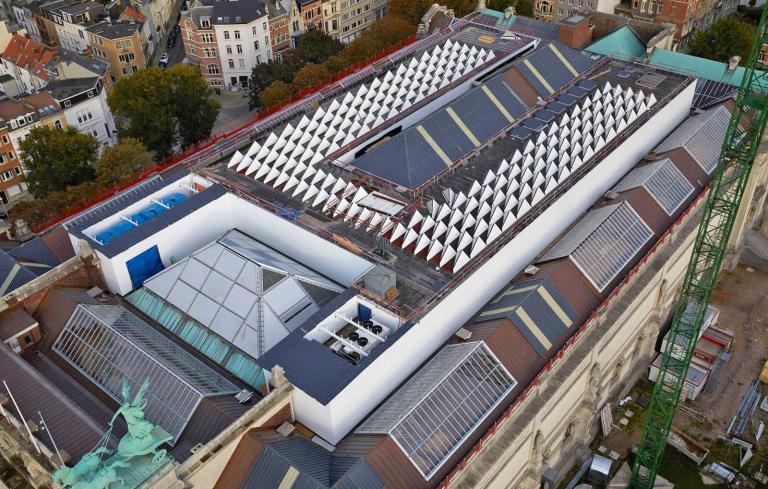Renovating glass roofs and skylights in historic buildings
Conserving and renovating cultural heritage are two concepts that often clash, because renovation projects often bring historic, aesthetic and technical needs into conflict with one another. This is also true when renovating glass roofs or installing skylights in historic buildings.

Problems can be avoided by having the right partners on board. That was the experience of two museums in Belgium – the Cinquantenaire Park (Brussels) and the Royal Museum of Fine Arts (Antwerp) – which recently underwent major renovations that are still ongoing: with expert knowledge and guidance from Forzon, the project went smoothly.
Royal Museum of Fine Arts, a natural light museum restored to its former glory
In many 19th century buildings, such as museums, stations, halls, etc., natural light played an important role. This was also the case for the Royal Museum of Fine Arts in Antwerp, where the architects of the time decided to create a natural light museum. However, over time this line of thinking has changed. The renovation that started in 2011 therefore focused on the light entering the building and the use of light within the museum.
As a result, domes played a key role in the construction of the museum roof. The northern light is distributed via the four atriums across all floors of the new museum. We installed the large domes on the gabled roofs and the central hall. The skylights in the roof of the museum galleries provide the best possible illumination thanks to their crystal-clear glass. We rebuilt the glass roofs whilst respecting the historic character of the building, whilst still keeping to our brief to keep the original measurements of the glass sections and the narrow profiles. All glass sections are made of crystal-clear single-pane laminated glass and where necessary, we reinforced the original steel structure.
We are incredibly proud of our success in ensuring that 100% of the light entering the building is neutral. To achieve this, we used low-iron glass (an ultra clear glass with a crystal clear appearance) so that the light falling on the paintings is completely natural. Because we used single glass in the skylight, the velum ceiling (just below the skylight) was fitted with insulated glass.
Cinquantenaire, 9,000 m2 of skylights in all shapes and sizes
The roof of the Cinquantenaire site was in need of renovation, but the roof of the site is extremely complex: it has pent roofs, gable roofs, skylights, small domes, etc., each with their own characteristics and challenges. Forzon is renovating approximately 9,000 m2 of skylights on this enormous roof measuring over 40,000 m2. Renovations are staged in several phases over a four-year period. We have already completed two years of this four-year period and have completed the skylights over the Japanese garden, the New Building and the cloister garden.
The museum has remained open during the renovation works, which presents quite a few challenges. The logistics are completely different from renovation projects where the building is closed to the public, such as the Royal Museum of Fine Arts. For example, there must be stricter safety policies in force and the building must remain watertight at all times. This is by no means the only challenge. Working at a great height on an old roof means considering all the possible logistical challenges: where to store equipment and materials, which areas are at greater risk of subsidence, how to get everything up onto the roof, where to create walkways for the workers and how to keep everything dry, etc.
As always with renovations of historic buildings, government criteria are incredibly strict. The appearance of the building must remain the same as much as possible. However, government criteria had some upsides as well: for the Cinquantenaire site, as it was possible to use an insulated skylight, leaving only the glass ceiling as single-glazed. The Cinquantenaire and the Royal Museum of Fine Arts in Antwerp have adopted different daylight design strategies for their concepts. Thus, in the Cinquantenaire the light colour for illuminating the galleries, display cabinets, artefacts and collections was designed to differ from the light colour used to illuminate paintings.
In addition to glass, the profiles are also an important factor. In historic buildings, it is not always easy to assess the underlying structure. Time, wear and tear, subsidence, etc. have all taken their toll on buildings. In order to build new, often heavier elements to sit on top of these old load-bearing structures, we had to pay a great deal of attention to the preparation, plan of action, method of securing components, etc. In many cases, it is only possible to replicate the 'original’ by extruding new made-to-measure profiles. However, extruding custom-made profiles takes a lot of time and requires careful planning.
When renovating skylights and glass roofs in historic buildings, many factors need to be considered, such as logistics, the historic character of the building, materials, customisation, timings, authorities, suppliers, insulation values, natural light, etc. Working with an experienced partner will always add value to your project. After all, skylights and glass roofs are a specialised product and Forzon is a specialist. Our step-by-step solution for the next renovation project is ready and available.